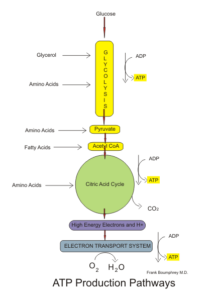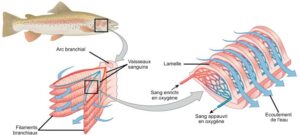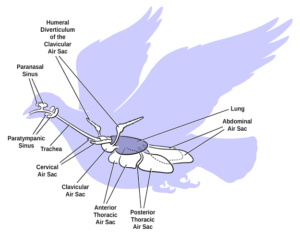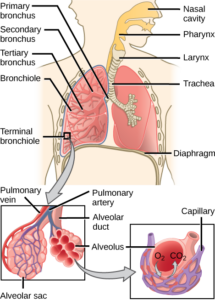Aerobic respiration is a mode of Respiration process in which an oxygen molecule is required to release energy from food. Here we are going to discuss about some most common aerobic respiration examples in brief.
Aerobic respiration is the primary mode of respiration in every multicellular organism. Some most common Aerobic respiration examples are-
- Respiration in Porifera
- Respiration in Coelenterata
- Respiration in Platyhelminthes
- Respiration in Aschelminthes
- Respiration in Annelida
- Respiration in Arthropoda
- Respiration in Mollusca
- Respiration in Echinoderms
- Respiration in Fishes
- Respiration in Amphibians
- Respiration in Reptiles
- Respiration in Birds
- Respiration in Mammals

Aerobic respiration examples from Wikimedia commons
Let’s have a closer look at the aerobic respiration examples.
Respiration in Porifera
Porifera is a primitive type of organism, performing aerobic types of respiration to produce energy in their body. In the lower group of organisms, diffusion is the only way for oxygen intake. Poriferans are aquatic organisms that have several pores through which they intake water along with food particles. Through choanocytes they purify the oxygen from water and use it for cellular respiration processes. After that the respiratory by-product carbon dioxide is also released from the body through the water.
Respiration in Coelenterata
Coelenterata or cnidaria is another phylum of lower group of aquatic organisms, which are most of aerobic respiration examples. They use direct diffusion process, which means in this process the oxygen molecule flows from according to the concentration gradient and enters the body of cnidarian. After that cellular respiration happens and energy is produced in the body.
Respiration in Platyhelminthes
Respiration in platyhelminthes is also one of the most common aerobic respiration examples. Platyhelminthes do not have any respiratory structure developed in their body. They only use their body wall for aerobic respiration. The oxygenated air diffuses through their body wall and enters into the Body, they use that oxygen for producing energy and then the carbon dioxide by-product is also released from their body following the same process.
Respiration in Aschelminthes
Just like platyhelminth, aschelminth respiration are also one of the most common aerobic respiration examples which do not have any respiratory system developed in the body structure. They also use their thin body wall for diffusion of oxygenated air into their body and complete respiration through it.
Respiration in Annelida
Respiration in annelida is also one of the most common aerobic respiration examples. In some common annelids such as Earthworm respiration process occurs through direct diffusion process via the skin of that organism. But in some other annelids such as polychetes gill-like projection, parapodia are present which work as a respiratory organ and controls gaseous exchange in organisms.
Respiration in Arthropoda
In arthropods different respiratory organs are found through which they complete the aerobic respiration process. In some organisms elastic air tube like structures develop named trachea through which they intake oxygen from air and distribute that in each and every cell of the body from cellular respiration. In some arthropods, lungs are present through which gaseous exchange happens in their body. In aquatic Arthropods like palaemon gills are present as respiratory organs, helping in aerobic respiration.
Respiration in Mollusca
In Molluscs different kinds of respiratory organs are found to help in aerobic respiration. Some aquatic Molluscs like Pila, Triton, etc develop ctenidia as respiratory organs. By ciliary beating the organism drives water current into the ctenidia surface and extracts oxygen from it for cellular respiration process. Some Molluscs have secondary gills or pulmonary sacs or lungs for the Respiration process.
Respiration in Echinoderms
In Echinodermata aerobic respiration occurs through simple diffusion or with the help of tube feet. In simple diffusion the oxygen enters into the body of organisms by diffusion and is used for cellular respiration. After burning the food materials ATP molecules and carbon dioxide are produced. Sometimes it is also found that the tube feet of the echinoderm helps in the gaseous exchange so that cellular respiration process can occur within the cell in presence of oxygen molecules.
Respiration in Fishes
The respiration of fishes are usually aquatic respiration in which the fish extract oxygen molecules from the surrounding water and use it for cellular respiration. As respiratory organ fish have gills, these are present near the head. The gills consist of several lamellae which increase the surface area and serve as the site of gaseous exchange in the fish body. This oxygen molecule is then used for cellular respiration and the produced byproduct then also released in the water.

Respiration in fishes from Wikimedia commons
Respiration in Amphibians
Amphibian respiration is also one of the most common aerobic respiration examples. In amphibians different respiratory organs develop in different stages in their lifecycle. Most of the cases the larval stage of amphibians generally perform aquatic respiration. In that stage the organisms use their skin, gills and tail fin for respiration. The oxygen diffuses through their skin and through gills they extract oxygen from the water outside. The tail fin increases the surface area and serves as the site of gaseous exchange in presence of several blood vessels. After metamorphosis the organisms came into the land environment and developed simple lungs which then served as the primary respiratory organ in them. It facilitates gaseous exchange and performs cellular respiration.
Respiration in Reptiles
Respiration in reptiles is one of the most common aerobic respiration examples. Reptiles develop lungs as their respiratory organ. There are some sac-like structures, alveoli is also present which increases the efficiency of gaseous exchange of gasses through lungs. The oxygen intake is carried through blood pigment in every cell of that reptile body and helps to burn food materials to produce energy.
Respiration in Birds
Compared with other vertebrates, birds require more efficient respiration than others, so that they can obtain oxygen from higher altitudes easily. The birds have smaller lungs and nine air sacs in their respiratory system. The air sacs make their respiration more efficient. While inhaling some amount of oxygen enters the lung of the organism and goes for cellular respiration, on the other hand extra oxygen enters into the posterior air sacs. At the time of exhaling while the lung proceeds to be empty the oxygen from air sacs enters into the lung and goes for cellular respiration process.

Aerobic respiration examples in birds from Wikimedia commons
Respiration in Mammals
Respiration in mammals is one of the most common aerobic respiration examples. The mammals have lungs as their primary respiratory organs. At the time of inhaling the oxygenated air enters into the nasal cavity then passing through the pharynx, larynx and trachea it enters lungs through alveoli. After that the inhaled oxygen carried out by hemoglobin of blood and reached each and every cell, where cellular respiration takes place.

Respiration in Mammals through lungs from Wikimedia commons
Summary
As a whole aerobic respiration is the primary mode of respiration in every multicellular organism where an oxygen molecule is required to produce energy molecules (ATP). Here we mention some most common aerobic respiration examples one by one. Hope this article on Anaerobic respiration examples will be helpful to you.
Also Read:
- Do bacteria have lysosomes
- Do lysosomes have proteins
- Is cytoplasm an organelle
- Are decomposers biotic or abiotic
- Polyunsaturated fatty acids
- How to find phenotypic ratio
- Transgenic plants examples
- Light independent reaction example
- Glycosidic bond
- Commensalism

Hello, I am Piyali Das, pursuing my Post Graduation in Zoology from Calcutta University. I am very passionate on Academic Article writing. My aim is to explain complex things in simple way through my writings for the readers.